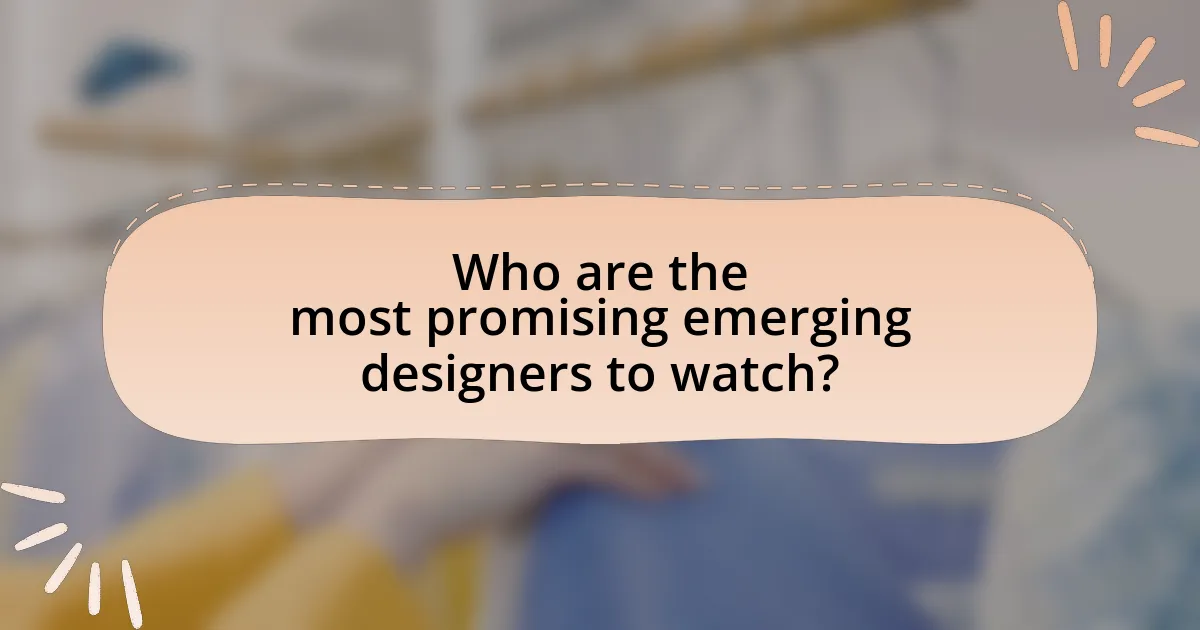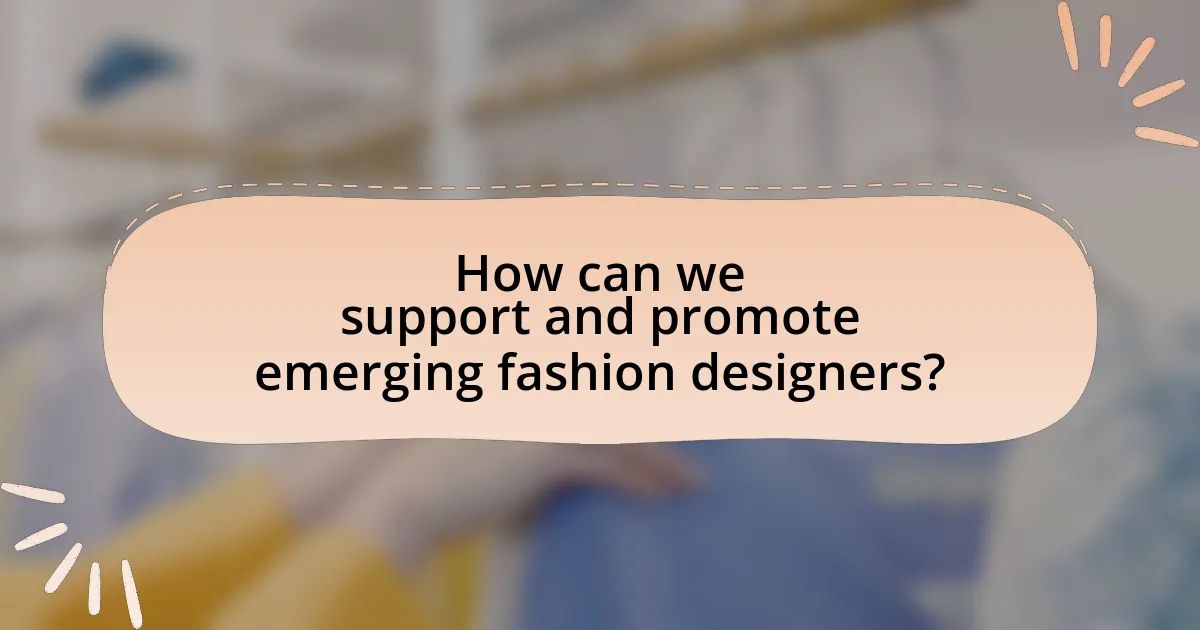The article “Fashion Icons of the Future: Emerging Designers to Watch” explores the evolving landscape of fashion through the lens of innovative and sustainable emerging designers. It defines a future fashion icon as one who merges creativity with eco-friendly practices, highlighting the influence of technology and cultural diversity in their work. Key sections discuss how these designers challenge traditional norms, set contemporary trends, and impact sustainability within the industry. Additionally, the article emphasizes the importance of recognizing new talent, the role of social media and online platforms in promoting their work, and the benefits of supporting local and sustainable fashion brands.
![]()
What defines a fashion icon of the future?
A fashion icon of the future is defined by their ability to blend innovation with sustainability while influencing cultural trends. This definition is supported by the increasing demand for eco-friendly practices in the fashion industry, as evidenced by a 2021 McKinsey report indicating that 67% of consumers consider sustainability when making purchasing decisions. Additionally, fashion icons of the future often leverage technology, such as digital fashion and social media platforms, to reach wider audiences and create unique, interactive experiences. This trend is highlighted by the rise of virtual fashion shows and the use of augmented reality in retail, showcasing how future icons will redefine traditional fashion paradigms.
How do emerging designers influence the fashion industry?
Emerging designers influence the fashion industry by introducing innovative ideas, fresh aesthetics, and diverse perspectives that challenge traditional norms. Their unique approaches often lead to the creation of new trends, as seen with designers like Telfar Clemens, who has popularized gender-neutral fashion and accessibility in luxury. Additionally, emerging designers frequently utilize sustainable practices, as demonstrated by brands like Reformation, which prioritize eco-friendly materials and ethical production methods. This shift not only attracts a conscious consumer base but also pressures established brands to adapt to changing market demands.
What trends are these designers setting in contemporary fashion?
Emerging designers are setting trends in contemporary fashion that emphasize sustainability, inclusivity, and digital innovation. For instance, many are utilizing eco-friendly materials and ethical production methods, reflecting a growing consumer demand for sustainable practices. Additionally, designers are increasingly embracing diverse body types and cultural backgrounds in their collections, promoting inclusivity within the fashion industry. Furthermore, the integration of technology, such as virtual fashion shows and digital clothing, is reshaping how fashion is presented and consumed, aligning with the digital transformation of retail. These trends are validated by industry reports indicating a significant shift towards sustainable practices and inclusivity, as well as the rise of digital platforms in fashion marketing.
How do cultural influences shape their designs?
Cultural influences shape designs by integrating traditional motifs, colors, and techniques that reflect the designer’s heritage and societal context. For instance, designers often draw inspiration from their cultural backgrounds, incorporating elements such as indigenous patterns or historical references that resonate with their communities. This practice not only honors cultural identity but also creates a unique aesthetic that distinguishes their work in the global fashion landscape. A notable example is the use of African prints by designers like Stella Jean, who blends her Italian and Haitian roots, showcasing how cultural narratives can inform contemporary fashion.
Why is it important to recognize new talent in fashion?
Recognizing new talent in fashion is crucial for fostering innovation and diversity within the industry. Emerging designers bring fresh perspectives, unique aesthetics, and novel techniques that challenge established norms, driving the evolution of fashion. For instance, the rise of sustainable fashion has been significantly influenced by new designers who prioritize eco-friendly practices, reflecting a growing consumer demand for ethical production. Additionally, acknowledging new talent helps to create a more inclusive industry, as diverse voices contribute to a broader representation of cultures and identities. This recognition not only benefits the designers themselves but also enriches the fashion landscape, ensuring its relevance and adaptability in a rapidly changing world.
What impact do emerging designers have on sustainability in fashion?
Emerging designers significantly impact sustainability in fashion by introducing innovative practices and materials that prioritize environmental responsibility. These designers often focus on ethical sourcing, utilizing sustainable fabrics such as organic cotton, recycled polyester, and biodegradable materials, which reduce waste and carbon footprints. For instance, brands like Reformation and Stella McCartney have pioneered eco-friendly production methods, demonstrating that sustainability can coexist with high fashion. Additionally, emerging designers frequently advocate for transparency in supply chains, encouraging consumers to make informed choices about their purchases. This shift towards sustainable practices not only influences consumer behavior but also pressures established brands to adopt similar strategies, thereby fostering a more sustainable fashion industry overall.
How do they challenge traditional fashion norms?
Emerging designers challenge traditional fashion norms by incorporating unconventional materials, promoting inclusivity, and embracing sustainability. For instance, designers like Marine Serre utilize upcycled fabrics and innovative techniques to create garments that defy conventional aesthetics, while brands such as Telfar advocate for gender-neutral clothing, breaking down barriers in fashion. Additionally, the rise of sustainable practices among these designers reflects a shift towards ethical consumption, as seen in the increasing popularity of eco-friendly collections that prioritize environmental responsibility. This approach not only redefines style but also reshapes consumer expectations and industry standards.

Who are the most promising emerging designers to watch?
The most promising emerging designers to watch include Telfar Clemens, known for his genderless fashion and accessibility, and Peter Do, recognized for his innovative tailoring and modern aesthetics. Telfar’s brand gained significant attention for its inclusive approach and the popular “Shopping Bag,” which sold out rapidly, highlighting consumer demand. Peter Do’s work has been featured in major fashion publications, showcasing his ability to blend functionality with high fashion, making him a standout in the industry.
What are the standout qualities of these designers?
The standout qualities of emerging fashion designers include innovation, sustainability, and cultural relevance. These designers often push the boundaries of traditional fashion by introducing unique materials and techniques, which reflects their commitment to creativity and originality. For instance, many utilize eco-friendly fabrics and ethical production methods, showcasing a dedication to sustainability that resonates with modern consumers. Additionally, their designs frequently draw inspiration from diverse cultural backgrounds, allowing them to create pieces that are not only stylish but also meaningful and reflective of contemporary societal issues. This combination of innovation, sustainability, and cultural relevance positions them as influential figures in the evolving fashion landscape.
How do their backgrounds influence their design aesthetics?
Design aesthetics of emerging fashion designers are significantly influenced by their cultural, educational, and socio-economic backgrounds. For instance, a designer raised in a multicultural environment may incorporate diverse textile patterns and color palettes, reflecting their heritage. Additionally, education in prestigious fashion institutions often shapes a designer’s technical skills and exposure to contemporary trends, which can lead to innovative design approaches. Furthermore, socio-economic factors can dictate access to resources, materials, and networks, ultimately impacting the uniqueness and sustainability of their designs. This interplay of background elements creates a distinctive aesthetic that resonates with their personal narratives and the broader cultural context.
What unique techniques do they bring to their collections?
Emerging designers bring innovative techniques such as sustainable fabric sourcing, 3D printing, and digital fashion design to their collections. For instance, designers like Marine Serre utilize upcycled materials to create eco-friendly garments, reflecting a commitment to sustainability. Additionally, brands like Balenciaga have incorporated 3D printing technology to produce intricate designs that challenge traditional manufacturing methods. These techniques not only enhance creativity but also address environmental concerns within the fashion industry.
Which designers are making waves in specific fashion sectors?
Designers making waves in specific fashion sectors include Telfar Clemens in gender-neutral fashion, known for his inclusive designs and the popular Telfar Shopping Bag, which has become a cultural icon. In sustainable fashion, Marine Serre stands out with her innovative use of upcycled materials and a focus on eco-conscious production, earning her the 2021 LVMH Prize. Additionally, Peter Do is gaining recognition in luxury womenswear for his modern tailoring and minimalist aesthetic, which has attracted attention from major fashion retailers. These designers are reshaping their respective sectors through unique approaches and impactful contributions.
What innovations are they introducing in streetwear?
Emerging designers are introducing innovations in streetwear by integrating sustainable materials and advanced technology into their collections. For instance, brands like Ader Error and Marine Serre are utilizing recycled fabrics and eco-friendly production methods, which align with the growing consumer demand for sustainability in fashion. Additionally, the incorporation of smart textiles, such as fabrics that change color or regulate temperature, is becoming more prevalent, showcasing a blend of functionality and style. This shift not only enhances the aesthetic appeal of streetwear but also addresses environmental concerns, making it a significant trend in the industry.
How are they redefining luxury fashion?
Emerging designers are redefining luxury fashion by prioritizing sustainability, inclusivity, and innovative design techniques. These designers are increasingly using eco-friendly materials and ethical production methods, reflecting a growing consumer demand for responsible fashion. For instance, brands like Stella McCartney have pioneered the use of vegan leather and recycled fabrics, setting a standard for environmental consciousness in luxury. Additionally, these designers are embracing diverse body types and cultural backgrounds, promoting a more inclusive representation in their collections. This shift is evidenced by the rise of brands such as Pyer Moss, which celebrates Black culture and heritage, thereby challenging traditional notions of luxury.

How can we support and promote emerging fashion designers?
To support and promote emerging fashion designers, industry stakeholders can provide mentorship, funding, and platforms for visibility. Mentorship programs connect new designers with established professionals, offering guidance and industry insights that can enhance their skills and market understanding. Funding opportunities, such as grants or sponsorships, enable designers to invest in their collections and marketing efforts, which is crucial for growth. Additionally, showcasing their work through fashion shows, online platforms, and social media increases their visibility and helps them reach potential customers and collaborators. According to a report by the Council of Fashion Designers of America, mentorship and financial support significantly improve the success rates of emerging designers in the competitive fashion industry.
What platforms exist for showcasing new talent?
Platforms that exist for showcasing new talent in fashion include social media networks like Instagram and TikTok, online marketplaces such as Etsy and Depop, and fashion-specific platforms like Not Just a Label and The Fashion Spot. These platforms enable emerging designers to reach a global audience, share their work, and connect with potential buyers and collaborators. For instance, Instagram has over 1 billion users, making it a powerful tool for visual storytelling and brand building in the fashion industry. Additionally, Not Just a Label focuses specifically on promoting independent designers, providing them with a dedicated space to showcase their collections and gain visibility.
How do fashion weeks and exhibitions contribute to their visibility?
Fashion weeks and exhibitions enhance visibility for emerging designers by providing a global platform to showcase their collections to industry professionals, media, and potential buyers. These events attract significant attention from fashion influencers, journalists, and retailers, which can lead to increased brand recognition and opportunities for collaboration. For instance, the New York Fashion Week and Paris Fashion Week are renowned for launching the careers of numerous designers, with many reporting a surge in social media following and sales post-event. This visibility is crucial for emerging designers, as it allows them to establish their identity in a competitive market and connect with a broader audience.
What role do social media and online marketplaces play?
Social media and online marketplaces serve as critical platforms for emerging fashion designers to showcase their work and connect with consumers. These platforms enable designers to reach a global audience, facilitating brand visibility and engagement. For instance, Instagram has over 1 billion active users, allowing designers to share their collections and build a following, while online marketplaces like Etsy and ASOS Marketplace provide a direct sales channel, making it easier for consumers to purchase unique items. This dual role enhances the accessibility of fashion, democratizing the industry and allowing new talent to thrive.
What can consumers do to help emerging designers thrive?
Consumers can help emerging designers thrive by actively purchasing their products and promoting their brands through social media. By buying directly from these designers, consumers provide essential financial support that enables them to continue creating and innovating. Additionally, sharing their work online increases visibility and can attract a broader audience, which is crucial for the growth of new fashion labels. According to a study by the Fashion Institute of Technology, consumer engagement on social media can significantly boost brand awareness and sales for emerging designers, demonstrating the impact of consumer support on their success.
How can supporting local designers impact the fashion ecosystem?
Supporting local designers positively impacts the fashion ecosystem by fostering innovation, sustainability, and community engagement. When consumers choose to support local designers, they encourage unique creative expressions that reflect cultural diversity and local craftsmanship. This support can lead to a reduction in carbon footprints, as local production often involves shorter supply chains and less transportation. Additionally, local designers contribute to the economy by creating jobs and stimulating local businesses. According to a report by the Council of Fashion Designers of America, local fashion industries can generate significant economic benefits, with every dollar spent on local fashion resulting in a multiplier effect that supports various sectors within the community.
What are the benefits of investing in sustainable fashion brands?
Investing in sustainable fashion brands offers environmental, social, and economic benefits. Environmentally, these brands typically use eco-friendly materials and ethical production processes, which reduce waste and carbon footprints. For instance, the sustainable fashion industry is projected to grow to $8.25 billion by 2023, reflecting increasing consumer demand for eco-conscious products. Socially, sustainable brands often prioritize fair labor practices, ensuring workers receive fair wages and safe working conditions. Economically, investing in these brands can lead to long-term profitability as consumers increasingly favor brands that align with their values, with 66% of global consumers willing to pay more for sustainable goods.
What are the best practices for discovering and supporting emerging designers?
The best practices for discovering and supporting emerging designers include actively engaging with fashion schools, attending industry events, and utilizing social media platforms. Engaging with fashion schools allows industry professionals to identify talent early, as many emerging designers showcase their work during graduation shows. Attending industry events, such as trade shows and fashion weeks, provides opportunities to discover new designers and their collections firsthand. Utilizing social media platforms, particularly Instagram and TikTok, enables broader visibility for emerging designers, as these platforms are often where they share their work and connect with audiences. According to a report by the Council of Fashion Designers of America, 70% of consumers discover new brands through social media, highlighting its effectiveness in supporting emerging talent.



